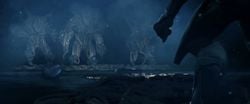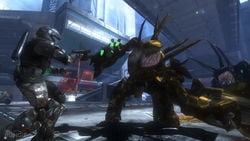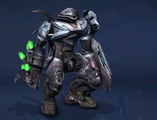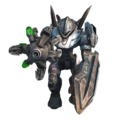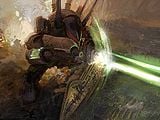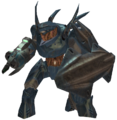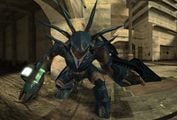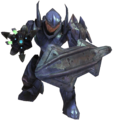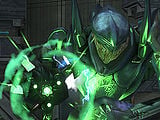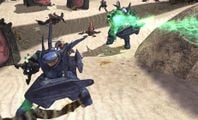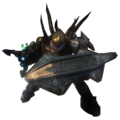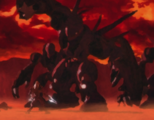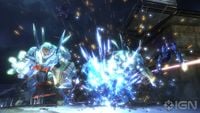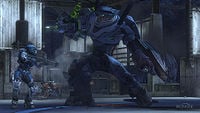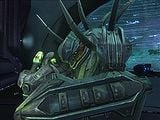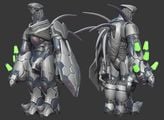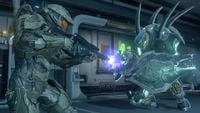Mgalekgolo: Difference between revisions
From Halopedia, the Halo wiki
Sith Venator (talk | contribs) (If someone could snag a pic of a Hunter from H2A that would be pretty sweet.) |
Mrsupersauce (talk | contribs) |
||
| Line 120: | Line 120: | ||
File:HaloCE-MgalekgoloHunter.png|Final in-game view of the Hunter as it appears in ''Halo: Combat Evolved'', with gun raised. | File:HaloCE-MgalekgoloHunter.png|Final in-game view of the Hunter as it appears in ''Halo: Combat Evolved'', with gun raised. | ||
File:HCE-MgalekgoloHunterAlt.png|Alternate preview of the Hunter in ''Halo: Combat Evolved'', crouched behind its massive shield. | File:HCE-MgalekgoloHunterAlt.png|Alternate preview of the Hunter in ''Halo: Combat Evolved'', crouched behind its massive shield. | ||
File:Ceahunter.png| Hunter in Halo CE: Anniversary | |||
File:Hunter1.jpg|A Mgalekgolo as seen in ''Halo: Combat Evolved''. | File:Hunter1.jpg|A Mgalekgolo as seen in ''Halo: Combat Evolved''. | ||
File:HCEA-MgalekgoloHunter.png|In-game preview of the Hunter as it appears in ''Halo: Combat Evolved Anniversary''. | File:HCEA-MgalekgoloHunter.png|In-game preview of the Hunter as it appears in ''Halo: Combat Evolved Anniversary''. | ||
Revision as of 00:52, November 23, 2014
- "They're all scary and angry and they like to smash things..."
- — Bungie
The Mgalekgolo[1] (Ophis congregatio, meaning "serpent union"[2]), is a gestalt of Lekgolo, which are small worm-like creatures that group together to exponentially increase their intelligence, strength, and maneuverability. Of the myriad Lekgolo collectives, the best known is the Mgalekgolo or Hunter, a bipedal form that is used for heavy assault. Ironically, the Mgalekgolo is among the least common Lekgolo configurations, but due to their formidable combat capabilities they are most commonly fielded by the Covenant.[1]
History
The Ark and reseeding
The Lekgolo were one of many species indexed by the Librarian as part of the Conservation Measure and preserved on Installation 00 from the firing of the Halo Array. They were subsequently returned to their homeworld, where they began rebuilding their culture.[1]
Development of civilization
In the years that followed the firing of the Halo Array, the Lekgolo began to rebuild society. Prior to 784 BCE, the Lekgolo had discovered space travel and colonized Forerunner installations orbiting their homeworld. Some of the colonies would begin to feed on the Forerunner alloys, gradually destroying the orbital structures.[1] However, the Lekgolo colonies had very differing diets, as some would eat only Forerunner alloys, while other would eat everything except Forerunner materials.[3]
After the formation of the Covenant, early experiments with the Luminaries reverse-engineered from the Forerunner Dreadnought in High Charity led the Covenant to the Lekgolo homeworld Te, which was located near Urs, the home system of the Sangheili. While the San 'Shyuum and Sangheili hoped to find a treasure trove of Forerunner artifacts, they instead found hives of Lekgolo inside orbital rings surrounding the planet. The rings were in fact the destroyed remains of an ancient Forerunner installation in orbit. The relics had been the Lekgolo's food for millennia, and the orbital rings were actually composed of digested-and-destroyed Forerunner relics that some of the Lekgolo had been consuming.[3]
The Covenant
The Covenant's Sangheili warriors faced heavy resistance from powerful Lekgolo gestalts, whose physiology gave them a tremendous and unexpected advantage in ground combat on the high-gravity world of Te, not only hampering, but even halting the Covenant's advance.[1][3] In ground combat campaigns the Lekgolo were mostly victorious, despite the valiant efforts of the Sangheili.[1] A Sangheili Arbiter sent to study the Lekgolo for a full year eventually suggested that the Covenant make an agreement with the Lekgolo and use them to an advantage in studying Forerunner artifacts. Thus terms for their induction into the Covenant were eventually met, despite communication difficulties. This event later came to be known amongst the Covenant as the "Taming of the Lekgolo". In their agreement to join with the Covenant, the Lekgolo worms, which fed on specific minerals, were consigned to investigate the Forerunner Dreadnought that resided in High Charity and help uncover its inner workings.[3] Their price for this trade was access to the Covenant's superior Slipstream space technologies and exploration of the Covenant space lanes.[1]
The Mgalekgolo gestalts, armed with thick armor plates and assault cannons, would come to serve the Covenant as shock troops. Numerous Mgalekgolo participated in the Human-Covenant War. During the Great Schism, most Mgalekgolo pairs sided with the Sangheili and the Swords of Sanghelios, though others remained with the Prophet of Truth and the main body of the Covenant. There is no known reason for the split in loyalty.[4] It is likely that the separatist Mgalekgolo split from the Covenant due to their respect for the Sangheili while those that remained with the loyalists may have done so out of loyalty to their agreement with the Covenant or fear of retribution.
Post-war
During the further conflicts in the wake of the Human-Covenant War many would fight on behalf of Jul 'Mdama's new Covenant order against humanity.[5] These Mgalekgolo participated in the battles of Requiem and Ealen IV.[6]
Description
Anatomy and physiology
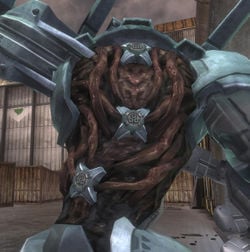
- Main article: Lekgolo
A Mgalekgolo is not a single organism, but rather a collective of small, orange, eel-like creatures called Lekgolo. In order to form a Mgalekgolo, dozens of individual Lekgolo bond with one another both physically and neurologically to form a single "hive-minded" community.[7] These gestalts are capable of manifesting in several different forms according to what goal they are striving to achieve and the amount of Lekgolo worms that are present. Their society is predominated by this combination of being able to create exponentially more intelligent creatures. The Mgalekgolo, employed by the Covenant as heavy infantry, is the most common form seen in combat during the Human-Covenant War, but is actually one of the more rarer and smaller forms in the Lekgolo society, used primarily in interaction with the Covenant hierarchy.[1]
Because of their make-up of several hundred worms instead of being a single large organism, the Lekgolo are one of the only species in the Covenant that cannot be assimilated by the Flood, as their unique physiology does not allow the organism to access a central nervous system or control them to any capacity. As such, there has never been a Mgalekgolo Flood combat form, though the flesh of the Lekgolo can most likely be used by the Flood simply for its biomass.[8]
The collection of eels that make up a Mgalekgolo's body are relatively unintelligent at the most basic level, but can form complex thoughts and emerge as a conscious individual when they combine into larger masses that communicate through chemical and electrical means. The neural net that Mgalekgolo develop enables them to be incredibly strong and very sensitive to their surroundings, allowing them to locate their enemies even without directly "seeing" them, such as when they are facing the opposite direction. Because of this, Mgalekgolo can think and work as an effective combat unit without even using verbal communication.
Culture
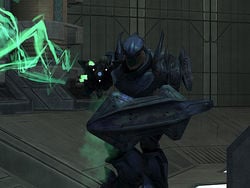
Mgalekgolo almost never associate or even communicate with the other races in the Covenant Empire. Sangheili are the sole exception; Hunters appreciate and acknowledge the Sangheili warriors' thoughts and adeptness in combat. To the other races of the Covenant, however, the Mgalekgolo are dismissive, scornful, and arrogant, and they are utterly contemptuous of their foes.[9] Mgalekgolo have no qualms about committing friendly fire against the "lesser" races, like Unggoy and Kig-Yar; during the Battle of Sigma Octanus IV, a Hunter was seen running over and killing an unaware Kig-Yar.[10] In battle, Mgalekgolo will attack foes regardless of any allies that happen to be in their line of fire.[11]
Many members of the Covenant are mystified and confused by the Mgalekgolo; their way of life is almost as alien to the Covenant as that of the Flood. A Sangheili Fleet Master once noted that Mgalekgolo were known to tear opponents apart with their "bare hands" whilst in a blood frenzy, and then suddenly pause to recite war poetry. It has also been said that Mgalekgolo meditate in their spare time, or before battle.[12]
When a single colony of Lekgolo becomes too big, the colony will divide in half to create two independent Lekgolo colonies. These colonies will share an extremely close and mysterious bond, referred to only as being "bond brothers", or "mates".[13]
The armor and assault cannons used by the Mgalekgolo were given to them by the Sangheili after the former joined the Covenant. Mgalekgolo that have split into "bond brothers" are recognized by spiked appendages that rise from their shoulders, which means that they are bonded to another Mgalekgolo.[3] Bonded Mgalekgolo colonies are dropped into battle together by the Covenant, as the Spartans learned: where you find a Mgalekgolo, there is always another close by. If one of the bonded colonies is killed, the other will go into a frenzied state, much like the berserk state of a Jiralhanae, or the suicidal charge of a desperate Unggoy. If left alone for a long period of time, however, they will adopt a "tactical split personality" of shooting followed by melee attacks.
Role in the Covenant
The most commonly seen variety of Mgalekgolo are hulking bipedal forms used for service within the Covenant military.[1] In this form, they are the strongest and most resilient combatants in the Covenant.[14] They usually stand between twelve to thirteen feet tall, but during combat they hunch themselves over to protect their vulnerable neck and midsection, reducing their height to roughly eight feet. Much larger bipedal Lekgolo assemblages that could easily be measured in stories have also been observed, but appear to be uncommon; the largest known Lekgolo forms reside within the armored shells of Covenant Scarab and Harvester walkers, the latter being known as a Sbaolekgolo.[15]
Mgalekgolo fight using assault cannons integrated directly into their armor, and they carry an enormous shield made of an alloy derived from the same material that forms Covenant warship hulls.[verification needed] This shield protects them from almost every form of plasma-based or ballistic weaponry available to Covenant and human infantry alike, and is a powerful melee tool capable of crushing anything in its path and allowing the Mgalekgolo to sweep away most enemies in close combat.
The assault cannon the Mgalekgolo wields operates in two modes; one firing a single explosive capsule of incendiary fluid,[16] the other spraying the fluid out like a beam.[17][18]
Religion
Mgalekgolo religious beliefs are poorly understood. While the Lekgolo joined the Covenant for its access to space trade routes and starships, rather than any real dedication to the Great Journey, at least some hold a concept of an "afterlife".[1][13] Many Lekgolo meditate in their spare time, or recite war poetry before or after battle, showing a more refined nature than would be believed of the hulking, savage warriors.[12] The fact that some allied themselves with the Sangheili during the Great Schism, while others remained with the original Covenant body, is evidence that individual beliefs play a major part in Mgalekgolo religion.[18] Anything further than this is speculation, as Lekgolo culture is extremely reclusive. Even their fellow Covenant know little about them other than that they continue to follow their own cultural traditions, rather than the homogenized religion of the wider Covenant.[9][1]
Language and communication
Little is known about the Mgalekgolo language. The known names of some Mgalekgolo seem to imply that they use very simple vowels, and few consonants—not nearly as many as are contained in the English alphabet. It is known that Mgalekgolo do not use vocal chords to speak; instead, they seem to vibrate the Lekgolo in their bodies to produce sound.[12] Their quiet nature amongst other races of the Covenant results either from difficulty speaking with other Covenant races or difficulty tolerating other Covenant races.[12] For inter-species communications, Mgalekgolo are capable of speaking at least the Sangheili language.[19]
Mgalekgolo tend to make very deep, low rumbling noises when detecting enemies or when wounded. When dying, they seem to emit a low-pitched scream. They also seem to chuckle after a kill. When angered, Mgalekgolo are also capable of releasing a loud, echoing roar.[20] Aside from that, Mgalekgolo barely talk. They are, however, capable of mimicking the language of other species via subsonic vibrations, forming words and sentences that are "felt rather than heard".[12][21]
Naming
Mgalekgolo have three names: a personal name, a bond name, and a line name. The personal name is given at their "birth". The line name represents the genetic heritage, being the name of the most successful Mgalekgolo of its ancestors. If one reaches a certain level of status, its offspring will have its personal name as their line name. The bond name, or their middle name, is taken between bonded pairs, colonies that must split into two due to excessive size. Examples of some Mgalekgolo names include Igido Nosa Hurru and Ogada Nosa Fasu.[22]
Homeworld
- Main article: Te
The homeworld of the Mgalekgolo was Te, a large planet orbiting the star Svir. It was home to approximately 1.98 trillion Lekgolo worms. Te is orbited by 25 moons, including Rantu and Uhtua. The planet has a high gravity and an atmosphere primarily composed of nitrogen, helium, and methane. Te is known to have very high concentrations of rare metals in its crust, many of which serve as food for the Lekgolo worms.[1] As a space-faring species, the Mgalekgolo also have several colonies, including one near the Sangheili home system.[3]
Ranking system
Unlike most Covenant forces, Mgalekgolo seem to possess no visible rank. As they are deployed more like equipment or weapons platforms rather than conventional troops, rank may simply not apply for them.
However, they can be deployed independently of other Covenant troops, which may indicate that a level of independence and responsibility may be granted, thus meaning that they may have a high enough rank to be trusted by themselves. During the Battle of Sigma Octanus IV, Mgalekgolo are seen guarding the crystal in Côte d'Azur, which is retrieved by Blue Team. Once of these Mgalekgolo killed a Kig-Yar by stepping on it, which may show that they are higher in rank than the Kig-Yar, although it is more likely that the Mgalekgolo merely did not care about the other alien's life.[23] During the Battle of Onyx, some Mgalekgolo apparently had command of lower-ranking Sangheili, even killing one of them for failing to follow orders, signifying they may have a higher military rank in the Covenant military than previously indicated.[24]
During the Battle of Mombasa, Mgalekgolo appear in two different forms in two different colors: the normal blue-armored Mgalekgolo that are armed with an assault cannon that fires a continuous stream of radioactive incendiary gel, and a gold-armored Mgalekgolo armed with an assault cannon that fires a single bolt of radioactive incendiary gel.[11]
Trivia

|
See our gameplay information related to Mgalekgolo on its gameplay page. |

|
Browse more images in this article's gallery page. |
- Halo: The Flood, mentions that Hunters have skin and a jutting spine. This is incorrect, as they were later revealed to be a compound of small worm-like creatures. However, this does not preclude the possibility that the worms may form a skin-like membrane on the outside of their colony for protection against more casual damage, and in Halo 3 a metal column can be seen after the back armor plating has been detached, perhaps forming an artificial "spine" for vertical support. Strangely, the reference to Hunters having spines was kept in the 2010 re-release of the novel.[25]
- At first, Hunters were meant to comprise the whole of Heretic forces on the Threshold gas mine.[26]
- The Hunter was inspired by the Pfhor Hunter from the Marathon series, as well as by the Drinniol, or Hulk, from the original Marathon. However, the Pfhor Hunter is actually a class of power armored soldier with a shoulder-mounted cannon rather than an arm-mounted cannon. The Drinniol also inspired the creation of the Drinol, Covenant species that was designed for Halo: Combat Evolved but was cut during development.
- Like most other races of the Covenant, Hunters' blood differs from that of humans. Mgalekgolo blood is bright, fluorescent orange and appears to have a very thick, slimy texture. It has also been noted that their blood smells strongly of burnt plastic, hinting that the make-up of their bodily fluids is drastically different from that of a human.
- When combating Hunters, a player can 'leapfrog' the charging melee attack, either jumping above or to the side of the Hunter. This exposes the rear armor to a quick shotgun blast or grenade stick, often resulting in death on lower difficulties. Although this tactic does not work as well on Halo 3: ODST, simply circling around behind the Hunter at the right time works the same way.
- In Halo 3, it is possible to splatter a Hunter with a M274 Mongoose.
- In Halo: Combat Evolved Hunters are not harmed by Type-33 fuel rod guns. This may be because you're not supposed to have Fuel Rod guns in Campaign, or it may be a precaution meant to prevent Hunters from injuring each other when fighting.
- Hunters have ranks in the actor variant tags. One variant is called 'Hunter' and another called 'Hunter major'.
- In Halo: Combat Evolved, a single shot from a pistol or sniper rifle to any non armored section will kill a Hunter; this is likely because the Hunter's exposed flesh was considered to be its "head."
- In Halo 2, it is impossible to kill or even damage a Hunter with a melee attack.
- In Halo Wars, a Hunter's shield can deflect projectiles that would almost always kill them in previous games, like Wraith Mortars and shots from the M808B Scorpion's main cannon.
- In Halo: Reach, Hunters have received a huge graphical overhaul. They are much more textured, are larger, have Forerunner symbols and emblems on their armor and appear to have some kind of eyes on their helmets.
- Hunters are also much tougher in Reach. They are capable of surviving multiple explosive hits and even repeated plasma grenade sticks. Their back armor is much more durable, making their weak point harder to expose. They will also raise their shield vertically when being attacked from the front, covering both their neck and mid-section to protect themselves from incoming fire and are less likely to turn around and expose their back to the player.
- In Halo: Reach, a near-miss from a Hunter's melee will cause the player's screen to shake violently.
- Although the Hunters present in Halo: Anniversary use the Halo: Reach skin, the Hunters are almost half the size of their Halo: Reach counterparts due to the much smaller skeleton frame used in the original game. Their abdomens also appear to be armored, though this armor doesn't do anything and they're just as vulnerable as they were in the original game.
- No Hunters are ever seen supporting the Master Chief during the events of Halo 3. This is because in the making of Halo 3, Bungie did not want to confuse players by having them with both the Covenant separatists and loyalists so they were only shown as loyalists.
- Despite appearing on the cover of Halo: Spartan Assault none actually appear in game.
Gallery
Early concept art of a Hunter for Halo: Combat Evolved.
Finalized concept art of a Hunter for Halo 2.
An in-game view of the blue-armored Hunter in Halo 3.
- Fuel Rod Beam Cannon in Action.jpg
A Hunter firing its assault cannon.
- Cov Hunter.jpg
Concept art of a Hunter for Halo Wars.
- Covenant hunter.gif
A pair of Hunters from Halo Wars.
An in-game view of the gold-armored Hunter in Halo 3: ODST.
- Gold Hunter.png
A pair of gold Mgalekgolo in Halo 3: ODST.
The Hunters as they appear in the Halo Legends episode, The Duel.
The Hunter as seen in the Halo: Reach Beta.
An in-game view of the Hunter in Halo: Reach, final build.
A Hunter on Corvette.
A Hunter in Halo 4: Forward Unto Dawn.
Conceptual three-dimensional render of a Hunter in Halo 4.
John-117 battling a Hunter in Halo 4.
List of appearances
Sources
- ^ a b c d e f g h i j k l Bestiarum
- ^ HBO Forums: Bestiaium Latin names translated
- ^ a b c d e f Halo: Contact Harvest, pages 269-271
- ^ Halo 2, campaign level Uprising
- ^ Halo 4
- ^ Halo: Escalation, Issue 2'
- ^ Halo: Contact Harvest, page 267
- ^ Halo: Evolutions - Essential Tales of the Halo Universe, Wages of Sin: page 301
- ^ a b Bungie.net: The Covenant Primer
- ^ Halo: The Fall of Reach, page 222
- ^ a b Halo 3: ODST
- ^ a b c d e Halo: Contact Harvest, page 277 Cite error: Invalid
<ref>tag; name "p190+1" defined multiple times with different content - ^ a b Halo: The Flood, "Chapter ??", page ??"
- ^ Halo 3 Instruction Manual
- ^ Halo 4: The Essential Visual Guide, page 130
- ^ Halo: Combat Evolved
- ^ Halo 2
- ^ a b Halo 3
- ^ Halo: Ghosts of Onyx, page 198
- ^ Halo 4: Forward Unto Dawn, Part 5
- ^ Bungie.net: Halo 3: ODST Field Guide
- ^ Halo: The Flood, page 163
- ^ Halo: The Fall of Reach, page 222
- ^ Halo: Ghosts of Onyx, page 358
- ^ Halo: The Flood (2010), page 181
- ^ Halo 3 Essentials: Disk ??
